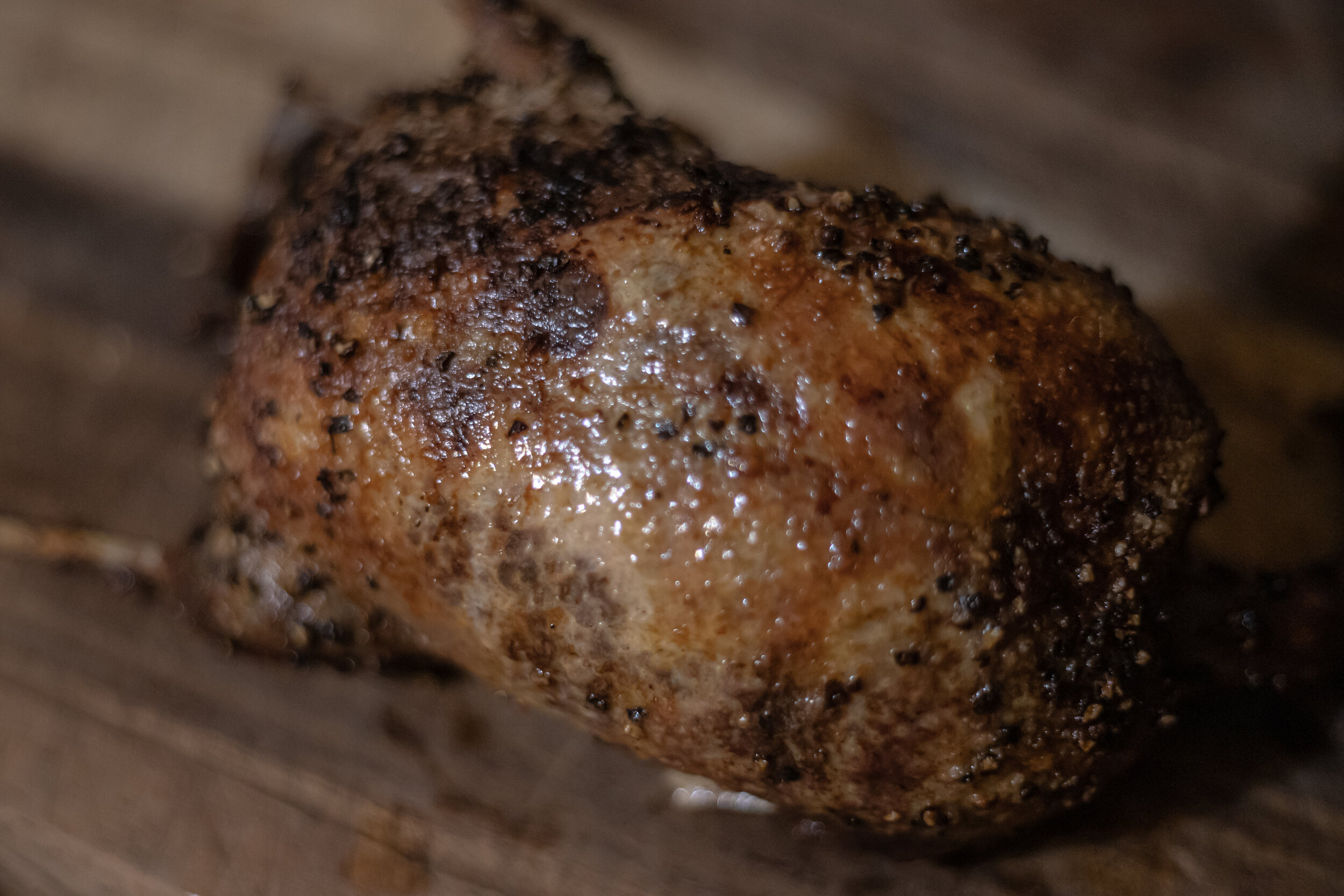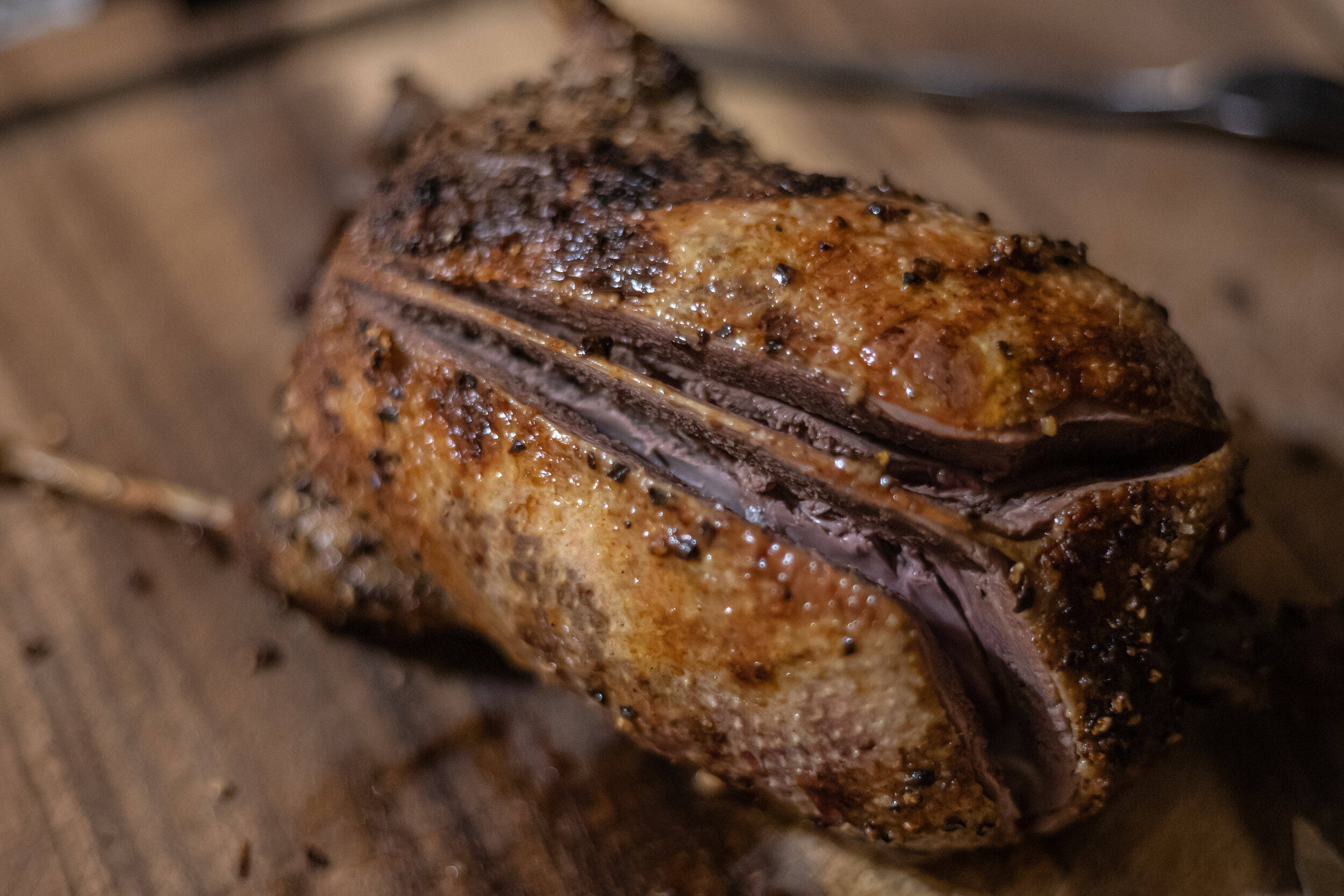Whole Roasted Duck
Corey Mulhair at SPLIT REED
Plucking a whole bird is about as much work as you can have to do to put a great waterfowl meal together, that being said it’s really not a lot of work. Some folks run pluckers or use the wax method to remove feathers, but I just sit on a chair on the deck with a trashcan and pluck by hand. I like to pluck when I can but personally find myself breasting any birds with more than a couple pellets in the breasts to use in sausage or as poppers. If there’s between 0-3 holes in a bids chest, I usually pluck the front of the bird and remove the two halves (breast and leg/thigh, skin on) or pluck the entire bird for whole roasting or smoking.
A cornfield killed, late-season mallard is my absolute favorite bird to cook whole, and a ricefield mallard or pintail is a close second. A bird without any (or only a few) shot holes in the meaty part of breasts is absolutely worth taking the 10 minutes to pluck and few more minutes to gut and prepare for roasting whole. If there’s any pellet holes in a bird, be sure to clean any bloodshot and remove ANY and ALL shot! Steel is no fun to bite down on, as you likely know by now.
Check out the recipe below for my method in preparing whole roasted duck.
Step 1 - Shoot a few ducks (in the head, preferably).
Step 2 - Pluck the ducks which haven’t been obliterated by a center-mass shooting buddy. When I pluck, my birds are cold and have been aged for a couple of days. We’ll talk about aging ducks in a later article. The cold (be it from outside or in the fridge) helps keep the fat/skin from tearing when you pluck. Pluck up the neck a couple of inches, and down to the poop shoot, as well as up the wing a couple of inches- and all around the breasts and back of the bird.
Step 3 - Remove the feet by slicing around the bone below the ‘knee’ knuckle, and bending backward, and twisting while you pull. This is will pull the feet off with the connective tissues from the leg. Then, slice around the wing bones below the ‘elbow’ and bend backward to remove the wing while keeping the bone attached.
Gutting - Cut the head off a couple of inches above the neck/chest junction. Next, cut off the lower abdomen below the breastplate. From here you can pull out the intestines, heart, liver, and then scrape any remaining lung matter out with your fingers as well as pull the windpipe and voice box out of the upper body/neck area.
See the photo below for the final product.
Step 4 - After removing feet, head, and wings and then gutting the bird, you can take a torch and burn off any small down feather parts still attached. Then thoroughly wash the bird’s cavity out, making sure all blood and lung bits have been cleaned from the carcass.
Preheat the oven to 450 at this point.
Step 5 - The flavor of the duck and fat will be rich enough for most palates, but a simple salt and pepper seasoning is often a great compliment to wild duck. To help bring the fat out to ‘self-baste’ and to allow it to crisp a little more, score the fat in a crosshatch pattern and rub the salt and pepper into the fat over the entirety of the bird. No need to season the cavity.
Sea Salt and Butcher grade Black Pepper.
Step 6 - With the bird on a roasting rack (nice to have, but not necessary) in an oven-safe dish (I use a pyrex dish) with the oven pre-heated, place the bird in the oven and bake at 450 for 30 minutes. I like to start with the breasts down, and flip the bird onto its back at the 15-minute mark and cook for the remaining 15. At this point, if it is a large and fatty bird I may increase it to 500 for 5 minutes more.
Step 7 - Remove cooked bird from the oven. Let rest for a few minutes then transfer to a cutting board or the final plate to be served on. I like to cut the breast and leg/thigh from the carcass and plate with sides- which is where the cutting board comes into play. I don’t however neglect the remainder of the bird. 'I’ll gnaw on the back and flank meat like a feral beast (it’s good stuff) after the breast and leg/thigh meat is consumed. When I’m feeling a little less civilized I will grab the whole bird with my hands and eat it right off the carcass (what you’re likely to do when you directly plate it).
I like a green vegetable with my duck- don’t get me wrong, a grain, or corn, or even a starch like potatoes (rice is starchy too!) goes well with a medium or medium/rare duck but grains and corn and other seeds are usually what field ducks have been munching on, and the nutrients they contain are absorbed by the birds and stored in the fat (many vitamins and minerals are fat-soluble).
Step 8 - By this point, you might have realized that the only thing left to do is to ENJOY!








